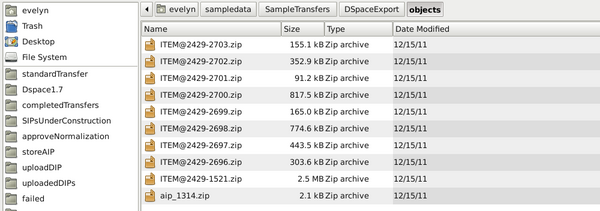Difference between revisions of "UM DSpace exports"
Jump to navigation
Jump to search
| Line 1: | Line 1: | ||
[[Main Page]] > [[Documentation]] > [[User Manual|User manual]] > [[User manual 0.8]] > DSpace exports | [[Main Page]] > [[Documentation]] > [[User Manual|User manual]] > [[User manual 0.8]] > DSpace exports | ||
| − | Archivematica can act as a "dark archive" for a DSpace repository - i.e. providing back-end preservation functionality while DSpace remains the user deposit and access system. Currently, Archivematica can ingest exports from DSpace 1.7.x. Ingest has not been tested on exports from DSpace 1.8. | + | Archivematica can act as a "dark archive" for a DSpace repository - i.e. providing back-end preservation functionality while DSpace remains the user deposit and access system. Currently, Archivematica can ingest exports from DSpace 1.7.x. Ingest has not been tested on exports from DSpace 1.8. [[Image:DSpace1g.png|600px|right|thumb|'''Figure 1''' A DSpace export with collection and item-level zipped files]] |
#The transfer should be structured similar to the one in Archivematica's sample data at ''sampledata/SampleTransfers/DSpaceExport'' ('''figure 1'''). This is a standard DSpace export with one DSpace AIP for the collection-level description and one for each of the uploaded objects. | #The transfer should be structured similar to the one in Archivematica's sample data at ''sampledata/SampleTransfers/DSpaceExport'' ('''figure 1'''). This is a standard DSpace export with one DSpace AIP for the collection-level description and one for each of the uploaded objects. | ||
#*The inclusion of the collection level export (eg ''aip_1314.zip'') is not mandatory. | #*The inclusion of the collection level export (eg ''aip_1314.zip'') is not mandatory. | ||
| − | #A typical zipped item folder will contain the uploaded object plus a license file, a METS file and possibly an OCR text file | + | #A typical zipped item folder will contain the uploaded object plus a license file, a METS file and possibly an OCR text file. '''Figure 2''' shows an example: |
| + | #*''bitstream_39691_txt'' = the OCR text file | ||
| + | #*''bitstream_8272.pdf'' = the object deposited in DSpace | ||
| + | #*''bitstream_8273'' = the license file | ||
| + | #*''mets.xml" = the mets file for the item | ||
| + | [[Image:DSpace2g.png|600px|right|thumb|'''Figure 2''' A DSpace item export]] | ||
Revision as of 19:52, 27 January 2012
Main Page > Documentation > User manual > User manual 0.8 > DSpace exports
Archivematica can act as a "dark archive" for a DSpace repository - i.e. providing back-end preservation functionality while DSpace remains the user deposit and access system. Currently, Archivematica can ingest exports from DSpace 1.7.x. Ingest has not been tested on exports from DSpace 1.8.
- The transfer should be structured similar to the one in Archivematica's sample data at sampledata/SampleTransfers/DSpaceExport (figure 1). This is a standard DSpace export with one DSpace AIP for the collection-level description and one for each of the uploaded objects.
- The inclusion of the collection level export (eg aip_1314.zip) is not mandatory.
- A typical zipped item folder will contain the uploaded object plus a license file, a METS file and possibly an OCR text file. Figure 2 shows an example:
- bitstream_39691_txt = the OCR text file
- bitstream_8272.pdf = the object deposited in DSpace
- bitstream_8273 = the license file
- mets.xml" = the mets file for the item

